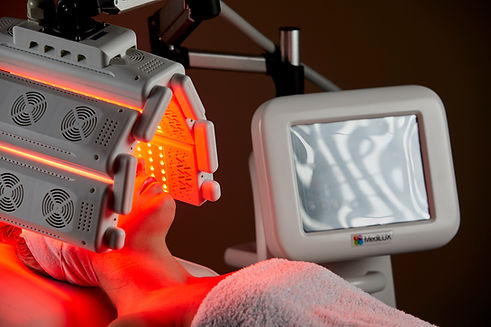PHOTODYNAMIC THERAPY (PDT)
What is PDT?
Photodynamic therapy (PDT) is a treatment option for pre-cancerous sun damage called actinic keratosis (AK) and superficial non-melanoma skin cancer (NMSC). It involves the use of a photosensitising agent and light to destroy abnormal skin cells.
Before undergoing PDT, a consultation is essential to determine if you are a suitable candidate for this treatment. A biopsy may be required to confirm the diagnosis of AK or NMSC. This most commonly involves taking a small shaving of a lesion, which will leave little to no scarring.

What to Expect during your PDT Treatment
The first step involves applying a topical photosensitising agent to the affected area, which is absorbed by pre-cancerous and cancerous skin cells.
Following a 60-minute absorption period, the area is exposed to a specific wavelength of light from our MediLUX LED device. This light triggers a chemical reaction that destroys the abnormal cells, while normal cells remain unaffected. Some heat, stinging, or discomfort may occur during the short treatment phase but typically subsides quickly

Aftercare
-
After the procedure, you may experience redness and swelling, which typically subsides by day 2-3, with redness and peeling resolving by day 7.
-
Avoid makeup for 5 days, and use soothing creams and SPF daily, such as AllMedic SPF 50+.
-
It's crucial to avoid sun exposure and bright light for 48 hours post-treatment, as your skin will be highly sensitive. Diligent sun protection, including protective clothing, hats, and broad-spectrum sunscreen, is essential, even indoors.
-
A follow-up appointment is usually scheduled 1 month after the PDT procedure to assess its effectiveness and check for recurrence. In some cases, a second treatment may be needed. Weekly photos of the treated area before your follow-up can help with assessment, though they are not essential.
Potential Side Effects
-
PDT is generally well tolerated, with swelling, redness, and discomfort subsiding within a few days. Skin redness may persist for weeks. Brown lesions may temporarily darken, and crusting usually resolves within 10 days, revealing normal skin.
-
Post-traumatic hyperpigmentation can occur, especially in those with darker skin types, but sun avoidance and SPF use can reduce this risk.
-
Scarring and pigment loss are rare. Some may experience more intense inflammation with blistering, which can take weeks to heal. Some lesions may require a second treatment or alternative therapies.
Pricing
1 Body Area: $450
Follow up treatment of the same area if required at 4-12 weeks $120
Medicare rebate available for consultation and biopsy
No Medicare rebate available for treatment.
Some private health providers and DVA may cover the costs of this treatment.
We recommend purchasing AllMedic SPF 50+ and post-treatment kit as part of your aftercare for optimal results and comfort.
